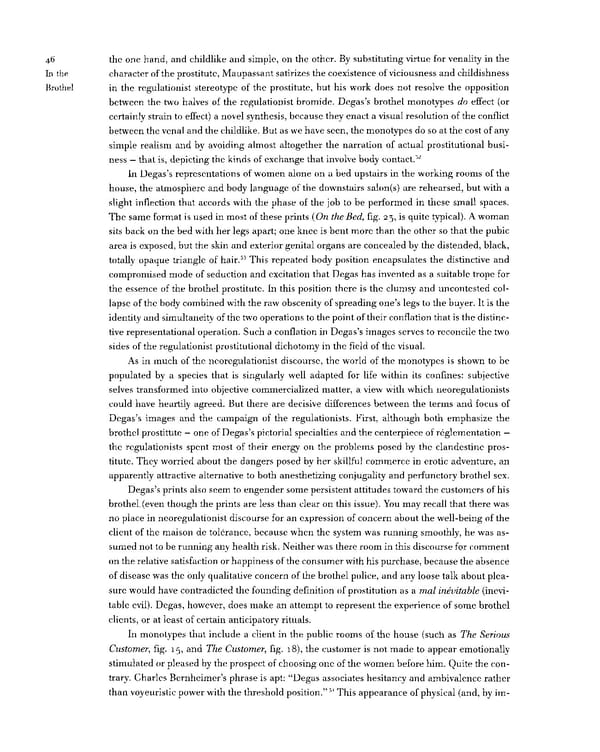46 the one hand, and childlike and simple, on the other. By substituting virtue for venality in the In the character of the prostitute, Maupassant satirizes the coexistence of viciousness and childishness Brothel in the regulationist stereotype of the prostitute, but his work does not resolve the opposition between the two halves of the regulationist bromide. Degas's brothel monotypes do effect (or certainly strain to effect) a novel synthesis, because they enact a visual resolution of the conflict between the venal and the childlike. But as we have seen, the monotypes do so at the cost of any simple realism and by avoiding almost altogether the narration of actual prostitutional busi- 52 ness — that is, depicting the kinds of exchange that involve body contact. In Degas's representations of women alone on a bed upstairs in the working rooms of the house, the atmosphere and body language of the downstairs salon(s) are rehearsed, but with a slight inflection that accords with the phase of the job to be performed in these small spaces. The same format is used in most of these prints (On the Bed, fig. 23, is quite typical). A woman sits back on the bed with her legs apart; one knee is bent more than the other so that the pubic area is exposed, but the skin and exterior genital organs are concealed by the distended, black, totally opaque triangle of hair.53 This repeated body position encapsulates the distinctive and compromised mode of seduction and excitation that Degas has invented as a suitable trope for the essence of the brothel prostitute. In this position there is the clumsy and uncontested col- lapse of the body combined with the raw obscenity of spreading one's legs to the buyer. It is the identity and simultaneity of the two operations to the point of their conflation that is the distinc- tive representational operation. Such a conflation in Degas's images serves to reconcile the two sides of the regulationist prostitutional dichotomy in the field of the visual. As in much of the neoregulationist discourse, the world of the monotypes is shown to be populated by a species that is singularly well adapted for life within its confines: subjective selves transformed into objective commercialized matter, a view with which neoregulationists could have heartily agreed. But there are decisive differences between the terms and focus of Degas's images and the campaign of the regulationists. First, although both emphasize the brothel prostitute — one of Degas's pictorial specialties and the centerpiece of reglementation — the regulationists spent most of their energy on the problems posed by the clandestine pros- titute. They worried about the dangers posed by her skillful commerce in erotic adventure, an apparently attractive alternative to both anesthetizing conjugality and perfunctory brothel sex. Degas's prints also seem to engender some persistent attitudes toward the customers of his brothel (even though the prints are less than clear on this issue). You may recall that there was no place in neoregulationist discourse for an expression of concern about the well-being of the client of the maison de tolerance, because when the system was running smoothly, he was as- sumed not to be running any health risk. Neither was there room in this discourse for comment on the relative satisfaction or happiness of the consumer with his purchase, because the absence of disease was the only qualitative concern of the brothel police, and any loose talk about plea- sure would have contradicted the founding definition of prostitution as a mal inevitable (inevi- table evil). Degas, however, does make an attempt to represent the experience of some brothel clients, or at least of certain anticipatory rituals. In monotypes that include a client in the public rooms of the house (such as The Serious Customer, fig. 15, and The Customer, fig. 18), the customer is not made to appear emotionally stimulated or pleased by the prospect of choosing one of the women before him. Quite the con- trary. Charles Bernheimer's phrase is apt: "Degas associates hesitancy and ambivalence rather 54 than voyeuristic power with the threshold position." This appearance of physical (and, by im-
 Prostitution & Impressionists Page 66 Page 68
Prostitution & Impressionists Page 66 Page 68